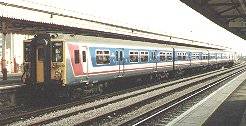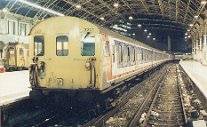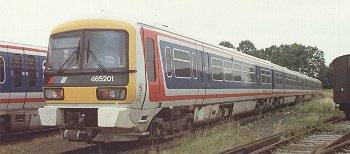
Suburban Electric Railway Association
Located at the COVENTRY ELECTRIC RAILWAY CENTRE, Rowley Road, Baginton, Warwickshire
Established
1996
The History Zone
The Southern Suburban Electric Network
Part 6 - Modernisation And Privatisation
British Railways was being re-branded and undergoing a major image transformation from the mid 1980s. The various regions were replaced with business sectors. The southern suburban lines came under the London & South East Sector, which also included all southern main lines and commuter routes from London to destinations within about an hour and a half from the capital. Some main line EMUs received the sectors livery of two tone brown with an orange stripe but none of the suburban units were so treated. The sector was further re-branded and relaunched as Network Southeast on June 10th 1986. With the new image came the promise to smarten up train, stations and just about everything else with the sectors colours of red, white, blue and grey. New trains were promised and a facelift for those older ones required to see further years of service. The NSE livery was quickly applied to the 455 fleet and in due course older units of HAP and EPB stock were also repainted.


The first significant addition to the network came on May 16th 1988 when the Thameslink services were introduced. These ran from destinations in the south such as Orpington, Sevenoaks, Brighton and Croydon to Blackfriars and then via the snow hill tunnel (which had been rebuilt and reopened after years of closure) to link up with the Midland region at Farringdon where the trains had access to the midland main line to serve destinations to Luton and Bedford.
To provide these new services brand new units of class 319 stock were built at York Works. They had the same body shell as 455 stock but with a much improved interior layout including high backed seats and toilets. The traction control was of the 'Chopper' system trial on latter built 455/9 units. The 319s worked on the 3rd rail south of Farringdon and were equipped to use the AC overhead lines for the journey north from there. The first batches were standard class only but a second batch with first class accommodation were built in 1989/90.
The advent of Thameslink rendered the Holborn Viaduct terminus redundant and it was closed on January 26th 1990, being demolished soon after.
Further new units were delivered to the central section during 1990/91 to eliminate the last examples of non gangwayed EPB stock from those lines. These were 24 two car units of class 456. They were compatible for multiple working with the 455 fleet and were based on the same bodyshell but with 319 style interiors, including a toilet.
In 1992 plans were announced to privatise all of Britain's railways and the passenger businesses were split into smaller companies. The southern suburban lines came under three companies whose boundaries closely followed those of the former Southern Railway divisions with a fourth company formed by splitting off the Thameslink services which by then no longer served any destinations in Kent. The south western division became 'South West Trains', the central division became 'Network South Central' and the south eastern division became 'South Eastern'. The later section was the recipient of the last EMUs ever built for the British Railways Board. The class 465 and 466 Networkers were built at York Works and Met-Cam of Washwood Heath between 1991 and 1993. The 465s were four car units with the 466s two car sets. All units featured three phase traction equipment, plug doors, saloon interior with toilets and on board information displays. They were the completion of a promise of new stock made back when Network SouthEast was formed in 1986. Their entry into service brought about an end to the last of the EPB, CAP and HAP units.

The four company franchises were let to private companies in 1995 and 96; Thameslink was bought by it's own management and South West Trains became owned by the Stagecoach bus group whilst both South Eastern and South Central passed into the ownership of a French based company called Connex.
At the time of writing all three divisions have new stock on order ready to enter service soon into the start of the 21st century.
